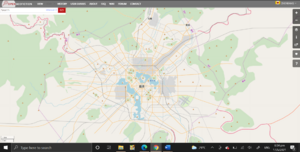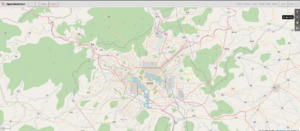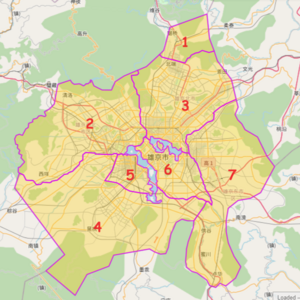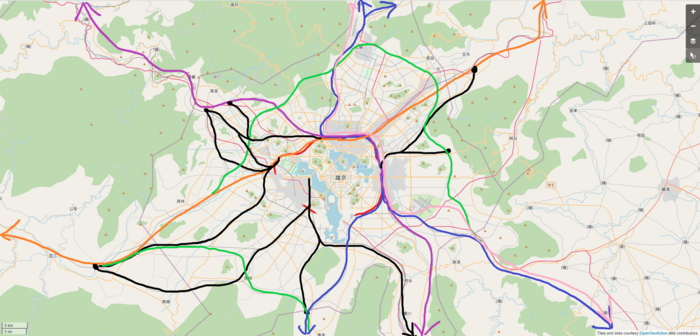Collab:Bai Empire/Xiongjing
If you have any questions you can reach out to User:Zhenkang (coordinator). Please keep in mind that the information below may change as things update accordingly in the future. Thank you. |
Xiongjing∈⊾ is the capital of the Bai Empire. This page is mainly to coordinate collaboration for the city with a list of available projects.
Participtation
Much of the city remains in construction. The project remains open for collaboration. All experienced users, even those not familiar with Chinese, are welcome to message me or ask on the discussion page if they want to participate. You can help detail a neighbourhood, or even map other major infrastructure like railway stations or universities.
General layout
Xiongjing, the cultural and political centre of the Empire, was constructed on a high-altitude plateau with two large lakes. The city, master-planned since its inception in 1822, is based around the government quarter within an 8 by 8 km zone. The government quarter is where most of the government institutions are located, with the palace as its centrepiece. Around the government zone are several key commercial zones around major rail stations, such as Central Station, Prince Terminus and East Station.
Generally, the more hilly and mountainous areas of the north, south and east are where many middle-class and upper-class people reside. Surrounding the rail lines are the industrial areas, with neighbourhoods of workers and low-income families. The flatter west and southwest are where there will be more master-planned neighbourhoods intended to cater to the growth of the city during the 60s to 80s, especially as part of recovery efforts since the War of Fellow Brothers and the Warlord Era that left much of the capital in ruins.
The size of Xiongjing Municipality proper is 3081.63 km², similar in size to Chengdu's urban area (3,679.9 km²). The city layout is also intended to be based on Chengdu, though other inspirations may include Mexico City.
Districts and Neighbourhoods
Xiongjing Municipality has a population of 13 million people. The municipality is divided into seven major planning districts (市区), which are in turn divided into numerous neighbourhoods/suburbs. Only a quarter of the suburbs are drawn on the map as for now. The neighbourhoods are not meant to be claimed individually; anyone can map throughout the city as long as they have permission. The grids should be similar to those in Taipei, Osaka and Tokyo (generally major Taiwanese, South Korean and Japanese cities) – dense yet fairly regular.
- Beiduan District (北端市区)∈⊾: Northernmost District of Bai which incorporates the Beiduan Airport. The area will serve as a regional commercial and industrial node in the north redeveloped from aviation industries that since shifted to Dongyue.
- Xiongjing Northwest District (雄京西北市区)∈⊾: Encompasses largely residential areas in the northwest areas, with key regional nodes at Qiongzhu (琼珠), Litian 栗田 and Guang'an (光岸) Sports Area. It also includes the outlying town of Qingluo (清洛).
- Xiongjing North District (雄京北市区)∈⊾: This district includes the capital's economic hub at Zhongyang along Xiongjing Lake and an industrial corridor along the northeast railway line. The residential areas here are catered towards the middle and higher income groups.
- Xiongjing Southwest District (雄京南西市区)∈⊾: Like Northwest District, the area is largely residential, but the area is more newly developed as the capital expanded into the area during the 80s. Key regional nodes include Huabang (华邦), Quanning (泉宁) and Huangtuo (晃捝).
- Chenghong District (成洪市区)∈⊾: Named after the founder of the Middle Bai Dynasty, this area used to be an industrial hub before being redeveloped into a new economic hub during the Weixin Programme of the 70s and 80s. The main railway station serving this area is to be operated under a separate private passenger rail company.
- Xiongjing Central District (雄京中央市区)∈⊾: The Central District is the heart of not only the capital but the Bai Empire. It is a distinct cultural core featuring various heritage areas that were established during Xiongjing's founding (in the 1800s). Bai's national governmental bodies are also headquartered in the Central District, including the National Palace and the Imperial Congress, alongside various embassies and diplomatic missions. The east of the district also includes Xiongjing East (雄京东), another commercial hub serving the east side of the capital.
- Xiongjing East District (雄京东市区)∈⊾: This area is considered the more "rural" area of the capital with more areas of farmland at the flatter region of the northern part of this district, while the south part leading out of the capital is more mountainous. Industrial and commercial areas will be located along the outlying roads, railways and expressways. This area also includes Dongyue International Airport and associated aviation industries.
Transport
The city will have an extensive bus and metro network to cater for the large population. Check the public transport viewer for the full view of transportation in the city. As of June 2021, the metro system is still in progress.
Bus
Bus routes, as of now, are not open until more of the city is mapped. However, if I were to permit bus routes, the following conventions are as shown:
| Convention |
|
Metro
For the metro, I rather not have any more lines until more of the city is mapped; the metro now is more of a sketch. The metro system is open for further changes based on consensus and discussion. See the collapsed map for the overview of existing metro lines.
Loading map...
Railways
 See also: Collab:Bai Empire/Railways
See also: Collab:Bai Empire/Railways
Most of the local railway lines will serve the suburbs (outer areas) of the city (that are not well-served by the metro). Xiongjing, being the hub of railways, will serve plenty of national rail lines. Alongside passenger services, there will be plenty of freight services. The rail network is also open for further discussion and implementation.
More detailing is needed for the following rail-related projects:
| Project name | Description | Project Status |
|---|---|---|
| Central Rail Corridor (between 春华 Chunhua and 峭田 Qiaotian) |
The Central Rail Corridor is where many rail lines passing through the city converge. What I require for this project is the realistic drawing of the amount of rail lines needed and the rail junctions at both ends of the Corridor (where the mainline branches). | |
| 闵泳 Minyong Railway station | Detailing needed for the railway station. Integrate the metro station serving it, along with a bus terminal. | |
| 音景 Yinjing Railway station | Detailing needed for the railway station. Integrate the metro and light rail interchange station serving it, along with a bus terminal. |
Aviation
The city has two airports. Further improvements to the areas surrounding the existing airports are welcome. Dongyue International Airport is open to most major international flights, while Beiduan International Airport is open to regional flights in Archanta and East Uletha.
| Project name | Description | Project Status |
|---|---|---|
| Dongyue International Airport | Major international airport for the city | |
| Beiduan International Airport | Former international airport. Still serves plenty of domestic routes along with the Emperor's hangar. |
Roads
 See also: Collab:Bai Empire/National Roads
See also: Collab:Bai Empire/National Roads
The main roads (highway=trunk,primary,secondary) are largely set in place, but the alignments are subject to change depending on the geographic features and detailing.
Street suffixes
| Baiyu name | Ingerish name |
|---|---|
| 高速公路 | Expressway |
| 高架路 | Elevated Road |
| 公路 | Highway |
| 环路 | Ring Road |
| 支路 | Side Road / Branch Road |
| 道/大道 | Avenue |
| 街/大街 | Street |
| 胡同 | Hutong |
| 弄 | Alley |
| 支弄 | Branch Alley |
| 巷 | Lane |
| 径 | Path |
By convention, it would be road name before the road suffix.
Motorways
As for now, three major motorways run into the city, but I am open to establishing more motorways once more of the city is detailed.
Government
While some might consider this section to be more suited for the country's page itself, I rather have it here than on that main page, since being the capital, it will have more relevance here.
As participants of the Empire should know, the Bai Empire is a semi-constitutional monarchy with the Emperor as the Head of State and the Chancellor as the Head of Government. Executive and legislative powers are shared by both the monarch and a bicameral parliament – the Imperial High Council (upper house) and the Imperia Senate (lower house).
In addition to the typical three branches of government (executive, legislative and judiciary), the Bai Empire has two additional branches (as envisioned by Sun Yat-sen for a democratic government for China). The Censorate, a carry-on from past imperial governments, "supervises and disciplines" politicians and civil servants, alongside auditing the national budget and resources. There is also the Examination branch that processes any prospective personnel who wishes to enter government service.
Five government branches
The following lists the five main government branches.
| Institution | Baiyu name | Branch | Project Status |
|---|---|---|---|
| Palace of the People | 人民宫殿 | Executive | |
| Imperial People's Congress | 帝国人民大会 | Legislature | |
| High Court∈⊾ | 高等法院 | Judiciary | |
| Supreme Court | 百帝国最高法院 | ||
| Constiutional Court | 宪法裁判所 | ||
| National Censure Commission∈⊾ | 国家谴责委员会 | Censorate | |
| Imperial Civil Service Institute | 帝国公务员学院 | Examination |
Ministries
The following lists the ministries of the Empire. Note that not all are mapped. Anyone is free to create a decent complex for each of the available ministries or propose more ministries. Add to the list once you are done.
| Institution | Baiyu name | Branch | Status and location | Functions |
|---|---|---|---|---|
| Grand Chancellor Office | 大统领公署 | Legislative | ||
| Ministry of Defence | 国防部 | Legislative | ||
| Ministry of Public Security | 国内安全部 | Legislative | ||
| Ministry of Foreign Affairs | 外交部 | Legislative | ||
| Ministry of Economy and Finance | 经济及财政部 | Legislative/Censure | Manages the national budget and economic forecast | |
| Ministry of Trade, Industry and Investments | 贸易、工业及投资部 | Legislative | Manages trade relations and businesses (including ownership dispute, merging of companies etc) | |
| Ministry of Agriculture, Environment and Resources | 农业、环境和资源部 | Legislative/Censure | ||
| Ministry of Infrastructure Development | 基础设施发展部 | Legislative/Censure | Urban planning | |
| Ministry of Transport | 交通部 | Legislative | ||
| Ministry of Health and Social Services | 卫生和社会服务部 | Legislative | ||
| Ministry of Education | 教育部 | Legislative | ||
| Ministry of Culture | 文化部 | Legislative | ||
| Ministry of Communications | 通讯部 | Legislative | ||
| Ministry of Law and Justice | 法律与司法部 | Legislative/Judiciary |
Agencies
The following lists the various governmental agencies of the Bai Empire.
| Institution | Baiyu name | Branch | Parent Ministry | Location (if built) | Functions |
|---|---|---|---|---|---|
| Government agencies | |||||
| National Revenue Agency | Censure | Finance | Collection and regulation of taxes | ||
| National Treasury and Reserves Board | Censure | Finance | Audits amount of national reserves and assets | ||
| Royal Bank of Bai | Censure | Finance | Monetary authority (issues banknotes and coins) | ||
| Royal Statistical Agency | Censure | Finance | Statistics | ||
| Press, Infomedia and Publication Regulatory Agency | Censure | Communications | "Regulates" publications and media in the Empire (aka Censorship) | ||
| Imperial Internet Safety Commission | Censure | Communications | "Regulates" (or censor) the Internet | ||
| Agency for Fair Trade and Enterprise | Censure | Trade, Industry and Investments | Oversees economic competition | ||
| Bai Consumer Protection Board | Censure | Trade, Industry and Investments | Protects consumer interests (whether unfair refund policies or faulty product) | ||
| Military Disciplinary Council | Censure | Defence | Military Personnel Discipline | ||
| Ambassadors Disciplinary Council | Censure | Foreign Affairs | Monitors activities of Bai diplomats and foreign ambassadors in the country | ||
| Corruption Investigation Bureau | Censure | Grand Chancellor Office | |||
| National Association for Women Rights and Gender Equality | Censure | Culture | Protection and promotion of women (and LGBT) rights | ||
| Royal Trans Registry | Censure | Culture | Protection and promotion of trans rights, including access to hormones, theraphy and surgery | ||
| Royal Bai Cartographic Society | Censure | Infrastructure Development | Surveying and mapping | ||
| National Ethnic Affairs Council | Examination | Culture | Promotes national harmony | ||
| National Religious Affairs Council | Examination | Culture | Promotes religious harmony | ||
| Bai Food Heritage Society | Examination | Culture | Standardisation of Bai food | ||
| Society for Baiyu Language Preservation | Examination | Culture | Regulates Baiyu | ||
| Regulatory Board for Bai Culture Preservation | Examination | Culture | |||
| Royal Examinations and Assessments Board | Examination | Education | |||
| Royal Physical Fitness and Performance Board | Examination | Education | |||
| Imperial Sports Association | Examination | Education | Oversees Bai athletes and sports events in the Empire | ||
| National Bai Arts Council | |||||
| Citizens Examination Board | For integrating immigrants into the Empire | ||||
| Imperial Security Bureau | Legislative | Internal Security | |||
| Imperial Commission for Foreign Intelligence | Legislative | Defence | |||
| National Agency for Technological Development | Legislative | Defence | |||
Foreign Affairs
The Bai Empire is very keen to establish relations with all nations. Embassies can be placed anywhere around the Government Core or any of the commercial areas, depending on your country's establishment. Older countries with longer historical ties will have theirs closer to the Core, while newer ones might have to squeeze in any available space around the capital.



